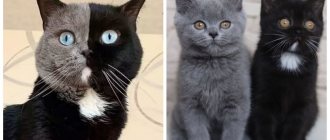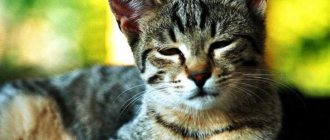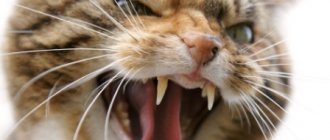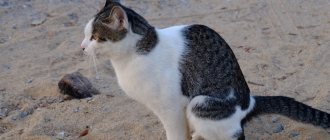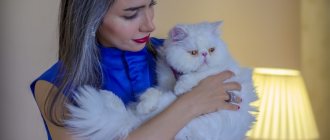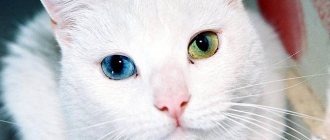To determine the parameters of the breed, it is important that cats have a suitable standard eye color. The exhibition rules also establish the conformity of the animal’s coat color with it. Irises are blue, yellow, copper, turquoise, green, brown and others. A deviation is considered a defect, the individual is discarded, its class is lowered or is not considered purebred.
What types of irises are there?
A cat's eyes are usually yellow. This is true for domestic mongrels, with rare exceptions. Each purebred variety has a strict standard for matching the coat and iris, for example:
- Blue eyes are found predominantly in white individuals. The Russian Blue cat breed must have turquoise shades of the iris; others are not allowed. Cats with yellow eyes are culled.
- Cats with brown eyes are allowed for certain species.
Exhibition rules are complex; for each breed there are certain acceptable parameters.
What causes color to form?
The color of a person’s eyes is primarily determined by heredity, but “technically” it develops as a result of a unique combination of the following factors:
- blood vessels in the iris give it cool shades: blue, gray and blue;
- the saturation of cells with melanin makes the eyes darker.
Thus, all existing eye tones are the result of a unique combination of blood vessel volume and degree of pigmentation. A low melanin content makes the iris light and cold, and its increased concentration in the cells gives it a rich, deep and warm color.
What does it depend on?
The color of a cat's eyes is formed in the womb and depends on the genetic code and hormonal levels in the animal's blood. It is impossible to influence the mechanism for determining color using third-party influence. After conception, melanin is synthesized in the cells of the future organ, which is responsible for the palette of fur and iris. In this case, pigment substances are delivered to the retina and follicles. The intensity of the color of the iris depends on the amount of melanin received - the less, the lighter, for example, a cat with brown eyes received more coloring matter than with golden ones. The process does not end after lambing. Which ones: brown, emerald, light or orange eyes will become clear after a certain time.
Blue-eyed Ojos Azules breed
In your search for a blue-eyed cat, the Internet will inevitably lead you to the young and controversial breed Ojos Azules (Spanish for “blue-eyed”). A distinctive characteristic of this breed is the rich blue or even cornflower blue color of the eyes, which is caused by a special mutation. These cats can be any color except color point, solid white, or with a lot of white.
Ojos Azules is not an established breed; to increase the population, cats of different breeds and even outbred animals are used for breeding, as long as they have blue eyes, and therefore the breed type has not yet been fixed, and there are still not enough enthusiastic breeders. There are no Ojos Azules nurseries in Russia, and in the world they can only be found in the USA.
Is it possible to change the color of a kitten's iris?
Based on the mechanism of color formation, the answer can be unequivocal - no. Once born, a brown-eyed cat and a cat with green eyes will remain so. However, there are prejudices that you can change the color, for example, with the help of a special diet during the pregnancy of the mother or an already born kitten. The initial gray or bluish color of the shell of newborn kittens should not be misleading. This is a physiological phenomenon; over time, the irises turn yellow or acquire a color characteristic of a particular breed. In some animals, the visual organs remain blue if this is genetically planned.
Why do kittens change color and when?
The color of the iris begins to appear half a month after the opening of the palpebral fissures. This is due to the ongoing work of pigments after lambing, which will finally form yellow eye color or any other color by the year of life. The rule is simple: if the irises turn yellow or green by 4 months, they will remain that way. A rare blue will also appear and it will become clear whether the cat will have amber eyes or brown. Based on this information, a simple conclusion is made that it is optimal to purchase a pet at 3-4 months of age, when the color of the iris has already been formed.
Color point cats with blue eyes
The color point color is considered a form of albinism: such cats have a light-colored body, while areas with a higher temperature - the front and rear limbs, tail, ears and muzzle - are dark-colored. This color is scientifically called temperature-dependent, or simply Siamese, although it is characteristic not only of Siamese cats, but also of many others.
There are about 20 breeds whose standards allow the color point color in many of its variations. If we talk about cats with deep blue, sapphire eye color, then finding it is not easy, but nevertheless possible.
Thai and Siamese breeds
It is worth paying attention to Thai and Siamese cats of seal point color (English seal - “seal”). This is perhaps the most popular and most contrasting variant of the color point color: the cat's body has a beige-cream tint, and the limbs are painted in a rich wax color, which can also be described as dark brown (in fact, it is a diluted black).
It is seal point Thai and Siamese cats that most often have eyes the color of deep azure. The richer the coat color, the brighter the color of the irises, which is also true for color points.
In addition to seal-point cats, blue eyes are also found in blue-point animals, whose limbs are colored blue or gray-blue, and also occasionally in red-point cats - cats with red pigment in their color.
Dark blue, almost violet eyes are observed in rarer variants of point colors: lynx point (tabby pattern on the limbs), tortoiseshell point (variegated, tortoiseshell pattern on the colored parts of the body) and tortoiseshell lynx point (a combination of the two previous options).
Despite the fact that Siamese and Thai cats are very close relatives, they have differences, which we wrote about in this article.
Heredity is very important
Kittens with the most intense and deep eye color are born to parents who themselves can boast of similar decoration, so a lot depends on the selection of a pair with the purest and brightest possible eye color.
However, genetics is a rather capricious thing, and therefore until a certain age, while the eyes of all kittens have blue, and sometimes even violet or violet eyes, it cannot be said for sure that the idea was a success. Perhaps with age, babies' eyes will lose their depth and intensity of color.
So, in a sense, buying the blue-eyed cat of your dreams is a lottery, but you can increase your chances of winning if you choose an experienced breeder and check out photos of the baby's parents in advance.
Choupette - Lagerfeld's blue-eyed beauty
One of the most striking owners of sapphire-colored eyes is Karl Lagerfeld’s pet, a cat named Choupette (“cabbage”). Everyone can admire the famous owner's pet - Choupette has her own iPad, an Instagram account, as well as several governesses, a personal chef and even her own line of cosmetics!
Presumably, Choupette belongs to the Burmese breed, but it is not easy to accurately determine its color, since photographs of the cat are processed with many photo filters before publication. Most likely it is a complex color, perhaps tortoiseshell or blue-cream point.
If you are interested in how the blue-eyed beauty lives and where the famous couturier got her from, you can read about it in our article “Karl Lagerfeld’s Cat”.
Cat breeds and iris
Among lovers of furry pets, there is an opinion that the color of the fur is associated with the color of the visual organs. For example, a cat with amber eyes can only be brown or tricolor, and black cats must have a light iris. The most inexperienced breeder knows that this is a misconception. Breeders often have to cull kittens from the standard precisely because the rule is violated by nature all the time. This does not mean that a kitten that has become outbred will be killed, it will simply be sold cheaper. Deafness in blue-eyed white cats is not considered a breed defect. The table shows the correspondence between the color of a purebred animal and eye color:
| Color name | Description | Cat fur color |
| Heterochromia | Various eyes of blue, yellow, gold, green (rare) | White, bicolors, tricolors |
| Honey golden | Yellow shades | Sepia |
| Green | Bright green, pale blue | Black, blue, chocolate brown, lilac |
| Brown | Brown-green, walnut | Tabby (except tortoiseshells) |
| Siamese | Blue | Himalayan (color-point) |
| Copper | Dark orange | Black, purple, dark red, cream |
| Blue | Light | White |
| Orange | Amber | Any |
| Yellow | Bright yellow | White, silver, tabby |
Have you ever seen a person with amber eyes? What about a person with green or red eyes? No?! Then, you will be a little surprised if you find out that all this is not fiction, not some myth that has been brought forward for centuries, but is quite real. Although there are not many people with such rare eye colors, they still exist .
People with rare eye colors exist, and they live among us
However, there is nothing sci-fi or extraordinary about this. Everything is quite natural, since it depends mainly on the pigmentation of the iris .
Peculiarities
First of all, you need to understand that a white cat owes its luxurious color to albinism genes. An albino kitten basically has no color; the albinism gene is responsible for the lack of pigmentation. If you have a real albino in front of you, then the iris of his eyes will be reddish. Such representatives of the cat kingdom are very rare. But blue-eyed albinos are more common. To get a white kitten, you need to breed a cat with the white gene with a male of any color. If you bring together a cat and a female cat, both of which have this gene in their kits, then the color of the kittens is indeterminable, it can be anything. As a rule, cats with this genotype have brightly colored eyes.
The gene responsible for piebaldity produces solid white spots, but outwardly the animal looks completely snow-white. It happens that the spots do not adjoin one another, then the animal turns out to be spotted. Eyes can be different colors. People who own white cats often associate them with characteristics that are scientifically inexplicable. For example:
- a white cat crossing your path brings good luck, success, winning;
- a domestic cat of this color should bring prosperity and financial prosperity to its owners, but a strange cat entering your house will most likely bring material loss;
- snow-white cats cannot be offended, otherwise they will attract misfortune;
- white cats are even credited with the ability to increase a woman’s chance of conceiving a child if she often strokes her pet’s light fur;
- When placing kittens, it is recommended to give cats to men and cats to women.
Of course, signs of this kind do not have any scientific evidence, so they cannot be taken completely seriously, but the advice “do not offend animals, pick them up more often” is quite appropriate in any case.
What is the iris of the eye: light, psycho-emotional and hereditary components
The iris of the eye is an almost impenetrable thin and mobile diaphragm of the eye with a pupil in the center, located behind the cornea (between the posterior and anterior chambers of the eye), in front of the lens. The color of the iris depends mainly on the amount of coloring pigment called melanin (responsible for color and affects the shade of skin and hair), as well as on the thickness of the eye shell itself.
There is a direct dependence of the color of the eyes on the reaction of the pupil to light, that is, the pupil, reacting to light, changes in size. When the pupil is constricted, the pigments of the iris are concentrated and the eyes begin to darken, and when the pupil is dilated, on the contrary, the pigments of the iris are dispersed and the eyes begin to lighten. In addition, the emotions that a person experiences also affect the size of the pupil, and, depending on the psycho-emotional state, his eye color may be different.
Magic properties
We have already mentioned the magical properties of the cat's eye stone more than once. As in ancient times, the gem is valued by sorcerers and magicians. In Ancient India, for example, there were legends according to which a person who has achieved harmony with a gem learns to understand the language of animals.
To prevent the energy properties of the crystal from being damaged, magicians advise not to wear it with other minerals.
According to medieval beliefs, the mineral warded off death from the wearer. Such beliefs arose due to the association with the cat, which has nine lives.
For nobles who left Russia after the revolution and civil war, the cat crystal helped them survive the hardships of the break with their homeland.
The talisman acts somewhat differently on members of the opposite sex, emphasizing the desired qualities. Men acquire strength of character, courage and perseverance. Women are charm, mystery and enchantment.
Psychics of our day call the following magical properties of the cat's eye:
- He is able to ward off trouble, rid the wearer of the evil eye and damage. Warning the wearer about danger, the talisman becomes heavier.
- The mineral also enhances the owner’s charm, making him more charismatic and attractive to others. Therefore, a talisman with a cat's eye is recommended for timid people. It will make yesterday's shy people more determined, purposeful and persistent.
- The crystal makes the wearer more attentive to the signs of fate that are sent from above to each person. It opens a connection with the cosmos and strengthens the aura. It is believed that thanks to the talisman one can learn to read hints and non-verbal signs that people use in communication.
- The cat's eye helps to establish contact between people. Its effect strengthens friendships, “cements” marriage, and helps maintain fidelity. If your partner is obviously not your person, then the mineral will make the breakup less painful.
- The mineral is able to activate hidden potential and awaken dormant talents. For those who have already found their way in creativity, the cat's eye helps not to fall into a crisis of ideas.
- The gem attracts cash flows. Jewelry with cat stones is often recommended to businessmen, traders, and financiers. Some magicians also recommend the mineral to those who are fond of gambling.
Although the cat's eye was used for black magic in the Middle Ages, now psychics do not advise doing so. The gem is very energetically susceptible, so the evil that the wearer emits can infect the crystal and return to the owner.
Top 5
What do you think is the rarest eye color? Honestly, it is difficult, or most likely impossible, to determine since there are so many different shades of eye colors, some of which are very rare and very rare.
Purple eye color is the rarest. In the photo, purple eyes in reality
Below is a list of 5 varieties of eye colors (from the rarest to more or less natural), which are less common, which makes them, in turn, more unique compared to the rest.
Purple eye color: hoax or reality!
It turns out that purple eye color is the rarest. There is an opinion that it is impossible to have purple eyes by nature. This is not entirely true. Purple eyes come from mixing red and blue shades.
From a genetic point of view, violet eyes are a similarity to blue eyes, namely a reflection, pigment or variant of the color blue. However, there are scientific facts that prove that people living in the remote and high altitude areas of North Kashmir have purple eye color. However, this unique eye color is very rare.
Varieties of purple eye color: ultramarine (bright blue), amethyst and hyacinth (blue-purple).
Nature has endowed all cats with a difficult character, but black cats are also distinguished by their unusual appearance. People blame these animals for all misfortunes and superstitiously try not to cross them on the road.
Apparently, this is how the subconscious fear of the dizzying beauty of animals in shiny coal-colored coats is expressed. But this color in different combinations is found in almost all cat breeds.
Lenses
Today, you can give your eyes almost any shade using lenses - there are options for permanent and temporary wear. If you want to stand out from the crowd, then why not, the main thing is to use high-quality products and not forget about the rules for their use.
Showbiz stars and young people who want to stand out from the crowd are very fond of such changes in their image. Retouchers and photographers process images in special programs; it is possible to change the shade of the iris in the video.
So if you want to briefly change the shade of your eyes, use lenses or Photoshop. Most colored lenses are intended for one-day wear; it is not recommended to exceed this period.
And remember - not all rare shades that you see in the photo are the same in nature.
Genetics of black color
The pigment pheomelanin is responsible for the red color, and eumelanin is responsible for the black color. In cat hair they are presented in the form of granules, the shape, quantity and location of which determine the color shade. Let’s leave the first one (red) aside, and consider the second one in detail.
- In black cat breeds, the B (black) gene is responsible for color. In the genotype of an animal, it can be represented in three alleles (species): dominant B, recessive b and bl.
- In the dominant state, the gene forms almost round (slightly elongated at the poles) eumelanin granules with a dense arrangement in the hairs. This gives a rich black color.
- The recessive allele b of the same gene stretches the pigment granules and moves them away from each other. It turns out to be a chocolate shade.
- The final form of bl is even more expanded eumelanin capsules and a sparse arrangement. On the hair this gives the color of cinnamon (cinnamon), characteristic of many breeds.
All other characteristics do not play a role in the color of interest - a large black cat is necessarily a carrier of the dominant B gene.
This is interesting! In black cats, there is no relationship between coat color and the sex of the animal. Their genes are not connected to the chromosomes that are responsible for dividing into “boys” and “girls.”
Characteristic eye color
The genetics of the pupil is less studied than the properties of fur. Researchers suggest the presence of a color gene and some polygenes that are located outside the studied structures and affect the characteristic features of the organism.
Felinologists identify three most common combinations:
- Black cats with green (grn) eyes are a classic color combination.
- The second group is orange, brown and amber-honey (org) eyes.
- The final position is in the copper color range (cpr). Fairytale black cats with red eyes actually come from this category.
When recessive alleles (b, bl) come into play and various shades appear on the cat's coat, the pupil color combinations automatically dilate. But absolutely black cats have only the three listed eye colors.
This is interesting! Black coat color is never ideal. It all depends only on the degree of its saturation, which hides some natural pigmentation flaws.
How to distinguish a cat's eye from a fake
The price of cat's eye stone is low, but they still try to counterfeit it. As a rule, glass or even plastic are used. Most often they imitate gray-green and yellow stones. It's not that difficult to expose scammers. The fake lacks several important properties of the original.
- Natural cat's eye is very durable. Swipe the gem across the glass or try to scratch it with a needle. Only harder minerals, such as diamond, can leave marks on a crystal. But now they can’t do it.
- Squeeze the crystal in your palm or simply press it against your skin. Plastic or glass will easily heat up from your body heat. Genuine stone will remain cool. It is almost impossible to simulate thermal conductivity.
- The most accurate way to check, apart from those used by specialists in laboratories, is to look at the stone in twilight lighting or in complete darkness. A genuine cat's eye will glow faintly, but if you wipe it with a cloth, the glow will become brighter. The purple specimens look most beautiful at night.
Sometimes the seller honestly says that he is selling an imitation or a laboratory mineral. In this case, if you are limited in money, you can buy a beautiful fake - no one can distinguish it from the original. However, a cat's eye stone has magical properties only if it is a natural specimen.
Bombay cat: black standard breed
Bombays are short-haired black cats, fit, graceful, with shiny golden-copper eyes. Their coat has a glossy satin texture, it is evenly colored along the entire length of the hair and lies tightly to the body. The long tail makes the miniature animal look like a wild predator.
The selection was carried out in the USA, where felinologists pursued two goals. Firstly, this is the desire to consolidate the obligatory black color in hereditary characteristics. Secondly, they wanted to obtain an external resemblance to a panther.
Breeds with acceptable black coloration
In nature, this color is not unique among cats and is often found in any breeding groups. The dominant B gene is stably present both in native breeds (which were formed under natural conditions) and in various hybrid communities or among outbred animals.
big black cats coexist with equally charcoal-shiny homeless strays, and this picture never surprises anyone.
American Bobtail
A rare breed of tailless cats. Their breeding began in the 60s in Arizona and continues to the present day. Among the parents of the American Bobtail are Siamese, Burmese, and Himalayan cats. A distinctive feature of the breed is the absence of a tail, and the color fades into the background.
More often than others, grey-red kittens with a tabby pattern (stripes and spots) are born. Fluffy black cats with a small overgrown tassel in place of the tail are less common, but it all depends on the parents and genetic predisposition.
The mixture of different breeds in the origin of the American Bobtail suggests the appearance of offspring of the most unusual colors, among which there are both solid black colors and combinations of black and white.
Siberian breed: black cat with green eyes
An indigenous Russian cat, which can be recognized as a national treasure of the country. The history of origin is unknown for certain, like most other breeds. But rich long fur, dense undercoat and adaptability to harsh climates indicate that the animal has perfectly adapted to its natural habitat.
The solid colors of Siberians come in two colors: red and black. But if the red tones are intersected by a tabby pattern (stripes, spots or blurred marble), then the coat of a long-haired black cat looks very impressive. In total there are more than 200 combined color options.
This is interesting! Siberian cats became the founders of the Neva Masquerade subspecies - a long-haired breed with a characteristic point mask in red or black shades.
Oriental cat
Oriental cats are champions among black breeds in terms of gracefulness. They are very graceful and sophisticated, on high slender legs, with an elongated wedge-shaped muzzle on a long neck and slightly slanting green eyes. In this color, the wool is evenly dyed along the entire length, from the root to the end.
Among representatives of this species, smooth-haired black cats are also often found.
Devon Rex
Devon Rexes are presented in two categories:
- Like many new breeds that gained official recognition in the 20th century, all modern Devons are descended from a kitten found in the litter of a mongrel cat. He had very large ears and curled fur, for these qualities the cat received the name Kirli (curly).
- It is a rare case when literally everything is known about the first animal in the group - Kirli was a black cat with eyes the shade of yellow amber.
Devons are very active pets - they love to climb onto the owner's neck and sit on his shoulders.
Like other representatives of the “eared” group, they are often called elves, hinting at “extraterrestrial” genetics. Among the popular black cat breeds, Devon cats are not considered. The population is small and black is not the most common color.
Turkish Angora
For more than a century, Turkey has had a program to preserve this breed as a national treasure. We are talking about a classic Angora cat with long or semi-long white hair and multi-colored eyes - yellow and green.
These animals began to be called Angora due to their very soft hair, by analogy with the well-known downy goat breed.
The spread around the world and the efforts of breeders have not benefited the classic white color. It is gradually giving way to other colors, and it is not surprising when black-brown cats with different-colored eyes and a fluffy long tail appear at exhibitions.
It must be admitted that in the pure black version, the shaggy Turkish Angora looks very impressive and rich.
Norwegian forest
Representatives of the aboriginal breed live in Northern Europe. One of the legends about its appearance connects the harsh, unpretentious Norwegians with the pampered southern Angora breed, which has adapted to living conditions in a cold climate.
The forest cat is large, with a double coat, dense undercoat and winter “decorations”: a mane, bib, whiskers and warm pants on the hind legs.
The portrait is completed by neat erect ears with tassels and thick pubescence on the inside of the auricle.
Norwegians are large animals that mature only at 4-5 years of age. Any color is allowed in the breed except those that indicate an undesirable crossbreed: fawn, cinnamon, chocolate and others. Large all-black cats are rare, but black and white cats with thick undercoat are common.
Application and care
The most ancient use for the cat's eye is amulets and talismans. It is not without reason that the stone has been used by magicians for centuries. But even if you are not a shaman, witch or sorcerer, the stone will help you protect yourself from dark energy, achieve happiness and success in life. Most of all, of course, it is suitable for women. And wearing such a talisman is worth it in plain sight.
The cat's eye is used in jewelry, decorative crafts and, of course, as a talisman.
Another area where stone is successfully used is the creation of jewelry. The best options include:
- Rings and rings with a cat's eye. In esotericism, it is believed that the talisman will absorb all the negative energy directed at the owner. Many people recommend wearing this ring as an engagement ring.
- A pendant with a gem will be a good decoration for a woman. It will help the hostess become more self-confident, make her attractive, and give her a special charm. Another interesting feature is that the cat’s eye creates an invisible psychological boundary between the wearer and the outside world. Only those people with whom the woman herself wants to communicate will be able to cross it.
- Bracelets with a cat's eye also look great. Like all other jewelry with a gem, they are worn in plain sight to enhance the protective effect of the mineral.
But not only jewelry is made from cat's eyes. This beautiful gem is an excellent raw material for various souvenirs. They make boxes, candlesticks, and rosaries from it. Larger products, such as facing tiles or figurines, are carved from synthetic types of stone. Outwardly, they are almost indistinguishable from natural ones.
In order for your jewelry to last as long as possible, you need to remember how to properly store a cat's eye stone. Its properties are such that it is quite durable, you don’t have to be afraid that the gem will break or be scratched. However, crystals still do not forgive neglect. What is the first thing the mineral doesn’t like?
- Abrasive cleaning products.
- Cosmetics.
- Household chemicals.
- Temperature changes.
- Close proximity to other stones - a cat's eye can push or scratch them.
From time to time, the stone should be washed without using aggressive household chemicals - only with warm soapy water and a soft cloth or brush. To prevent the mineral from losing its shine, after cleaning it is not left to dry, but wiped dry.
Other breeds of black cats
Cats with black fur are found in almost all aboriginal groups. The Maine Coon is a very interesting breed - a champion in height, length and weight. It is in this breed that huge black cats in solid color or with white accents are often found.
Unlike the newly bred mestizos, all natives are good-natured, loyal to people and endowed with good health. The only difficulty is breeding. International expert organizations require compliance with the rules for crossing with other breeds.
Grooming
Hair care for cats depends on the breed and physical condition of the animal.
- Long-haired and semi-long-haired pets need regular brushing. The procedure must be repeated daily, and during molting - several times a day.
- When caring for a black cat with short hair, special combs and brushes are used that collect small hairs.
Important! The “fur coat” of any cat is an indicator of its health. If the fur loses its shine or falls out excessively, you need to reconsider the animal’s diet and show your pet to a veterinarian.
